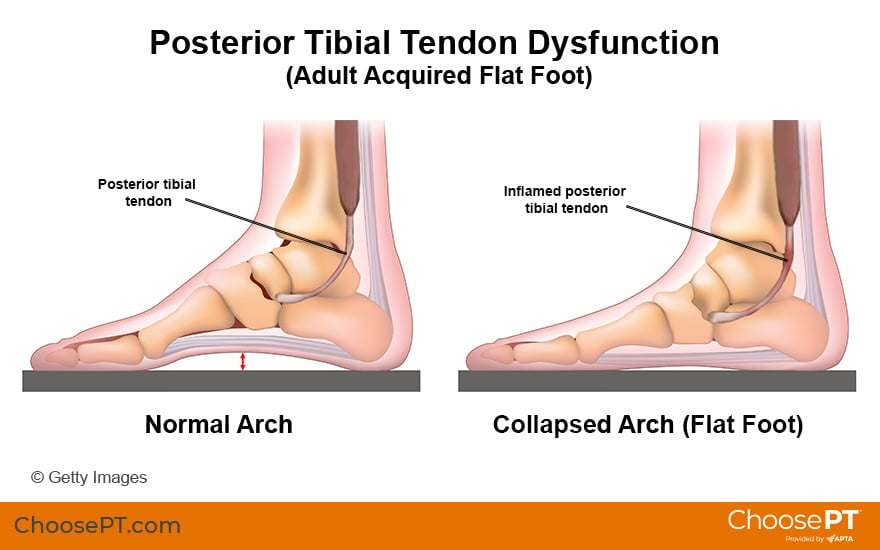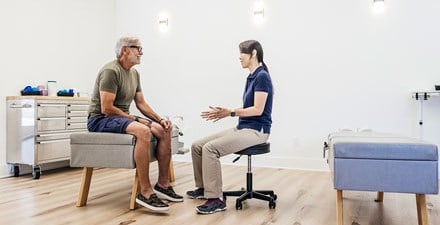Physical Therapy Guide to Posterior Tibial Tendon Dysfunction (Acquired Flat Foot in Adults)
Posterior tibial tendon dysfunction is a condition that causes pain in the arch of the foot. It usually worsens over time, rather than occurring with a specific incident or injury. PTTD is the most common form of "flat foot" (collapsed arch) that develops in adulthood. It occurs in up to 10% of people and affects women more often than men. It usually affects only one foot, although in rare cases, some people develop it in both feet. Overuse is the most common cause. A physical therapist can help you regain the ability to walk and run without pain after injuring your posterior tibial tendon.
Physical therapists are movement experts who improve quality of life through hands-on care, patient education, and prescribed movement. You can contact a physical therapist directly for an evaluation. To locate a physical therapist in your area, visit Find a PT.
What Is Posterior Tibial Tendon Dysfunction?
The posterior tibial tendon runs along the inside of the lower leg and foot. Its main functions are to help move the foot and support the foot's arch. With overuse, this tendon can become painful with activities, such as walking and running. With continued strain, the tendon can become overstretched or rupture, leading to the collapses of the foot’s arch, making the foot flat.
PTTD typically occurs gradually, especially with overuse. Risk factors include hypertension, obesity, diabetes, previous trauma, or steroid exposure. The condition often can improve with activity modification, prescribed exercises, and the help of a physical therapist.

Signs and Symptoms
The following are some common signs and symptoms of PTTD, which usually come on gradually:
- Pain on the inside of the foot (along the posterior tibial tendon) with use or when touched.
- Flat foot (collapsed arch).
- Pain in the inside of the foot or weakness when rising onto the toes during a single-leg heel raise.
- Pain when using the arch of the foot.
How Is It Diagnosed?
Your physical therapist will perform a complete evaluation to assess your condition and determine any factors that may contribute to it. They will start by gathering information about your health history. They may ask you questions such as:
- When and how did your symptoms begin?
- Have you ever experienced this before?
- What activities are you having trouble doing?
- What activities do you want to get back to doing?
Your physical therapist also will conduct a physical exam. They will gently press around your foot and ankle to see if it is painful to the touch. Your physical therapist may:
- Test your strength, balance, and flexibility.
- Observe how you can move your foot and ankle.
- Watch how you walk.
Your physical therapist also will test and screen for other, more serious conditions that could be causing your pain. They may team with an orthopedic doctor or other health care provider to confirm the diagnosis. You may be referred for further tests such as an X-ray, MRI, or ultrasound.
PTTD has four stages. Your condition may be classified as:
- Stage 1: The tendon is inflamed, but the foot's arch is still present. You may not be able to tolerate as much activity as usual.
- Stage 2: The tendon is painful, stretched out, and may have ruptured, causing the arch to collapse.
- Stage 3: The ankle joint is now affected as well as the arch, and you may develop arthritic symptoms, such as pain and stiffness, in the ankle.
- Stage 4: Arthritic pain and stiffness is present in more than one of the three joints in the ankle.
How Can a Physical Therapist Help?
Your physical therapist will develop a treatment program based on your diagnosed stage of PTTD and your specific needs, challenges, and goals. They will work with you to help you:
- Restore your flexibility.
- Return to your highest level of function.
- Manage your pain.
Your physical therapist also will partner with other members of your health care team as needed to address any related problems.
Your physical therapy program may include:
Patient and family education. Your physical therapist will teach you how to safely get back to activities. They may make suggestions for shoes or orthotics that can improve your symptoms.
Activity modification. Your physical therapist may recommend ways to modify your activities or activity level until you can resume your highest level of participation.
Muscle strengthening. Your physical therapist may have you do exercises for your foot, ankle, and leg in the clinic and at home. Your exercise program may involve using your body weight, machines, stretch bands, or cuff weights.
Improving flexibility. Your physical therapist may help you stretch your foot and ankle to restore flexibility.
Manual therapy. Your physical therapist may perform hands-on techniques (manual therapy) to help your foot regain its normal motion and reduce your pain.
Balance training. Your physical therapist may teach you exercises to help improve your balance.
Gait training. Your physical therapist may work with you to improve your walking pattern (gait) to help you get back to activities such as walking, running, and exercising without pain.
If Surgery Is Needed
You may need surgery if conservative treatment does not resolve your symptoms within a few months, or in more severe cases of PTTD. The type of surgery will depend on the stage of your symptoms. After surgery, you will follow a recovery program guided by your physical therapist over several weeks. Your physical therapist will help you minimize pain, regain motion and strength, and safely return to your activities.
Can This Injury or Condition Be Prevented?
Since overuse or a sudden increase in physical activity can cause PTTD, the best way to prevent it is to ease into new activities slowly. A physical therapist can help you begin or change your exercise routine to help you reduce your risk of injury.
What Kind of Physical Therapist Do I Need?
All physical therapists are trained through education and experience to evaluate, manage, and treat various symptoms and conditions. You may want to consider seeing a physical therapist who is:
- Experienced in treating the foot and ankle.
- A board-certified clinical specialist in orthopedic or sports physical therapy, or who has completed a residency or fellowship in orthopedics or sports. This physical therapist has advanced knowledge, experience, and skills that may apply to your condition.
- A practice that focuses on orthopedic injuries.
You can find physical therapists in your area with these credentials and clinical expertise through Find a PT, a tool built by the American Physical Therapy Association.
General tips when you're looking for a physical therapist (or any other health care provider):
- Get recommendations from family, friends, or other health care providers.
- Ask about the physical therapist’s experience treating posterior tibial tendon dysfunction before making an appointment.
- Be prepared to describe your symptoms in as much detail as possible. Make a note of what makes your symptoms worse or better.
The American Physical Therapy Association believes that you should have access to information to help:
- Inform your health care decisions.
- Prepare you for a visit with a health care provider.
The following resources offer some of the best scientific evidence related to physical therapy treatment for posterior tibial tendon dysfunction. They report recent research and provide information on the standards of practice in the United States and worldwide. They link to a PubMed* abstract (which may offer free access to the full text) or other helpful resources. You can read them to learn more or bring a copy to your health care provider.
Knapp PW, Constant D. Posterior tibial tendon dysfunction. In: StatPearls. Treasure Island, FL: StatPearls Publishing; 2021. Article Summary in PubMed.
Ross MH, Smith MD, Mellor R, Vicenzino B. Exercise for posterior tibial tendon dysfunction: a systematic review of randomised clinical trials and clinical guidelines. BMJ Open Sport Exerc Med. 2018;19;4(1):e000430. Article Summary in PubMed.
Ling SK, Lui TH. Posterior tibial tendon dysfunction: an overview. Open Orthop J. 2017;11:714–723. Article Summary in PubMed.
*PubMed is a free online resource developed by the National Center for Biotechnology Information. PubMed contains millions of citations to biomedical literature, including citations in the National Library of Medicine's MEDLINE database.
Expert Review:
Jun 10, 2022
Revised:
Jul 21, 2022
Content Type: Guide
Acquired Flat Foot
PT, DPT
Annette Karim
PT, DPT, PhD, board-certified clinical specialist in orthopaedic physical therapy and fellow of the American Academy of Orthopaedic Manual Physical Therapists, on behalf of the American Academy of Orthopaedic Physical Therapy Foot and Ankle Special Interest Group.
Frank Edwin DiLiberto
PT, PhD, board-certified clinical specialist in orthopaedic physical therapy, on behalf of the American Academy of Orthopaedic Physical Therapy Foot and Ankle Special Interest Group
You Might Also Like...
Health Tips
Better Fit, Better Movement and Function: Why Toe Room in Shoes MattersOct 31, 2025
Some shoes can alter the natural walking stride of healthy people and lead to bunions, hammer toes, or other foot and walking problems. This advice from
